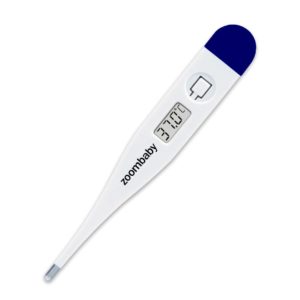The duration of highest fertility is known as ovulation which is a consequence of the ovum coming out from the ovarian follicle. This period lasts from 4 days prior to ovulation until a day after the ovum is released. Although the ovum remains for 24 hours the fertile period may be longer since the sperm can remain in the woman’s body for about 5 days.
An accurate prediction of the period of peak fertility is very important for women who are looking to become pregnant. For this, the date when ovulation occurs must be estimated correctly. Some of the methods to increase chances of pregnancy are with the use of a saliva ovulation predictor, cervical position, testing for ovulation and BBT charting. Physical symptoms may include lower abdomen discomfort, cervical position and cervical mucus changes.
Fertility Charting and Basal Body Temperature
Once ovulation has occurred there will be a rise in body temperature by 1.5 degrees Fahrenheit, detected by a basal thermometer. This is caused by the increasing amount of progesterone, a hormone that is present during ovulation. The increase in temperature makes it warm and fertile for implanting the egg and also enables the subsequent development of the embryo.
2-3 days prior to the maximum increase in temperature a period of maximum fertility can be achieved in a woman’s body. Due to the fact that the thermal shift occurs after ovulation, BBT charting will not predict ovulation. But the variations in basal temperature can help you track the changes in menstrual cycle and predict when ovulation might occur. Once you have predicted your most fertile period you can schedule intercourse accordingly.
Zoom Baby supplies a digital thermometer and BBT charting pack that will allow you to track accurately the changes in your body temperature.
Interpreting Your BBT Chart
Once you begin tracking basal body temperature (BBT), reviewing your chart for patterns can reveal useful insights. Here’s how to interpret key BBT chart features when trying to conceive:
Temperature shift – A clear biphasic pattern on your chart – lower temperatures followed by a thermal shift of at least 0.2°C along with higher second half readings – indicates ovulation occurred. Mark the last lower temperature day as your estimated ovulation date.
No thermal shift – Lack of a significant or sustained temperature uptick may mean no ovulation. This could signal an ovulation disorder worth seeing your doctor about if trying to conceive.
Temperature drop – An obvious temperature dip around 7-10 days past ovulation may indicate implantation of a fertilised egg. But drops can happen for other reasons too like illness.
Erratic temperatures – Lots of peaks and valleys may reflect poor sleep, inconsistent timing or illness. Try to take temperature same time daily after best stretch of sleep.
Cervical fluid changes – Increased, stretchy, lubricative cervical mucus that correlates with last lower temp on the chart shows hormonal changes consistent with impending ovulation.
Menstruation – Bleeding/spotting is marked with M or dots. Short cycles under 21 days may mean issues with ovulating. Long cycles over 35 days also can reflect ovulation problems.
Medications and stress – Make notes on chart since some medications and major stress can impact basal body temperature. Account for these when analysing patterns.
Compare monthly charts – Lining up charts from previous cycles will showcase your personal rhythms and consistency of ovulation timing. Notice if cycle length or luteal phase length varies monthly.
Keeping detailed records not only helps confirm ovulation but may highlight potential fertility problems sooner. Be patient when first charting since interpreting accuracy improves with more data from consecutive cycles charted over time.
Consult your doctor if you have concerns like no thermal shift for multiple cycles, very short or long cycles, or dramatic changes in cycle characteristics which could signal issues like polycystic ovarian syndrome (PCOS) or egg quality decline. Most charts will show variation month-to-month – but major, persistent disruptions warrant medical review.
Luteinising Hormone, Ovulation and Ovulation tests
Ovulation Tests – Increased quantities of Lutropin before ovulation, called LH surge, can lead to ovulation. LH surge is an accurate way of predicting fertility. You can conceive 36 hours after an LH Surge has occurred. The LH Ovulation test can detect an LH Surge which is the most opportune time for ovulation and can help you schedule your intercourse. This surge happens over a period of 1-2 days and with a positive LH surge you can also be sure of a high degree of fertility and ovulation.
Saliva Ovulation Tests
These tests detect changes in the levels of hormones especially of oestrogen. A slow increase in oestrogen levels can be seen just before ovulation takes place. An ovulation microscope is used to gauge fertility by seeing the changes in saliva during your cycle. Although the oestrogen surge is slower to occur than a LH surge you can still predict ovulation to be occurring within the next 72 hours. The saliva will contain crystal patterns caused due to increase in oestrogen levels. The patterns look like fern fronds and are hence called ferning patterns. You can predict fertility and ovulation accurately if you see ferning patterns.
The tests above are useful but show different strengths. LH urine ovulation tests will give a window of 26-35 hours for ovulation whereas ovulation microscopes can do so more in advance which in turn will make it easy for you to plan sex 2-3 days prior to ovulation and increase chances of pregnancy.
Fertility, Ovulation and Cervical Mucus
Cervical mucus shows an increase in volume during the menstrual cycle. It also shows changes in texture and consistency. Ovulation occurs due to hormonal changes which comes about due to such an increase in volume and changes in consistency. When the cervical mucus increases to its maximum volume and becomes very slippery it indicates peak fertility.
Pre-Ovulation – Dryness without mucus follows the menstrual period. Mucus will increase slowly and will have either a yellow, white or cloudy hue along with a sticky consistency.
During Ovulation – Mucus will increase and it will have a semi transparent, egg-white kind of look with a slippery texture. This is the period of maximum fertility.
Following Ovulation – The mucus will become less slippery and it will become sticky with the cloudiness hue increasing along with increased dryness as well.
Photo by Charles J on Unsplash
This post first appeared in November 2021
Zoom Baby is a leading supplier of Pregnancy Tests and Ovulation Test Kits






